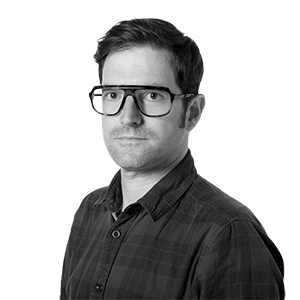Between particles and metaphors


The particles that make up the fingers that typed these words and the particles that make up the fingers that are sliding them across the screen in front of you existed 13.8 billion years ago (give or take a trillionth of a second). They were just organized differently. The recombination process they underwent to give rise to something capable of thinking about itself in order to write it down, and something capable of reading about itself in order to think about it, as is happening now through this text, is a mystery. Ideas like this are what the film makes you think about. Superradiance, by artists Memo Atken and Katie Peyton Hofstadter, which recently opened the Radical Science program at the Center for Contemporary Culture in Barcelona, a cultural project that proposes a reflection on current frontier science through the eyes of various disciplines.
Although the mystery of the reorganization of elementary particles in conscious beings is profound, it is not unique. Good luck! Because without mystery there would be nothing. Neither science nor poetry. Neither music nor cinema. Mystery is the engine of any human activity, whether artistic or scientific, and the fuel that makes it all work is imagination. When mystery and imagination coincide, one of the results that can come out of them is a type of scientific research that seeks the fundamental causes of phenomena, that makes no concessions to pragmatism, but is fueled by creativity, that takes risks and assumes failure as a possibility inherent to the unknown territories that the vocation of exploration has. Thus, an activity emerges that could well be called radical science. A science that works on the threshold of what is known with what is unknown. A science that raises more new questions than answers, most of which cannot be addressed with the language and tools of science. A science, therefore, that necessarily calls upon ethics, philosophy, sociology, visual arts and poetry.
Because science alone cannot answer the question of how to use gene editing tools. Only to cure diseases or to enhance human capabilities such as strength or intelligence? Can these tools give rise to two kinds—or, if applied long enough, species—of people, the edited and the original? Science alone cannot interpret a possible observation of the origin of the Universe either. What will we discover if gravitational wave detectors allow us to observe the Big Bang? Is it really the origin of space and time and of all the things that the human mind has conceived and those that it has not yet?
For all this and because, as the late Jorge Wagensberg said, "nature does not understand disciplines or study plans," the program Radical science brings scientists into dialogue with economists, writers and historians. Structured in four blogs dedicated to biomedicine, quantum physics, cosmos exploration and the energy transition, this project is built on debates with the presence of the writer Jorge Volpi; the discoverer of the first exoplanet, Didier Queloz; the energy expert and Bill Gates' favourite author, Vaclav Smil; the historian of climate denialism, Naomi Oreskes; or the director of the Carl Sagan Institute for the Study of Life in the Universe, Nathalie Cabrol.
In addition to requiring a broad view, frontier science is a great factory of metaphors —in fact, science is perhaps the most sophisticated metaphor that the human mind has ever produced. Radical scientific research attempts to express the world in its own language, a language built on errors, mathematical imagination and the will to transcend, but which does not have to be the language of the world. It is a problem similar to that faced by poets or filmmakers, who must explain with words or external images what the heck is going on inside those clumps of particles that we humans are. And this disconnection between language and the object of study opens up a space made up of intuitions, of substitutions that are not quite exact, of intellectual stammerings and daring metaphors. When one of these attempts reaches a greater precision than expected and there is a correspondence between language and object that goes beyond the usual, even if it is momentary or even intuited, that is when aesthetics appears, that very pleasant click of a well-made box closing, as David Foster Wallace said.
For all this the program Radical science The programme also explores this aesthetic dimension of frontier scientific research. It does so with a show of works integrated into the debate programme and curated by Irma Vilà, with a series of poetic residencies curated by Joan Duran - the poets Pol Vouillamoz, Lluís Calvo, Mireia Casanyes and Anna Aguilar-Amat will infiltrate four Catalan research centres and transform experience into poas and will transform experience into poes into poes.
In this respect, the programme is also radical. Or frontier. Or experimental, if one looks at it through the lens of composer John Cage, who said that an experiment is a process whose outcome cannot be predicted. Indeed, we do not know what will come out of these poetic residencies, nor of the creative paths that the artists Pablo Barquín and Anna Díaz of Hamill Industries will follow. It is a great cultural experiment with the clear aim of helping to understand as completely as possible the current frontier science and how it can reconfigure the world by 2050. And also, to make scientific knowledge valid in an era in which self-serving falsehoods, hate messages, and polarization are proliferating. Today's world is so complex that only with a broad view and a radical search can the framework be removed.
